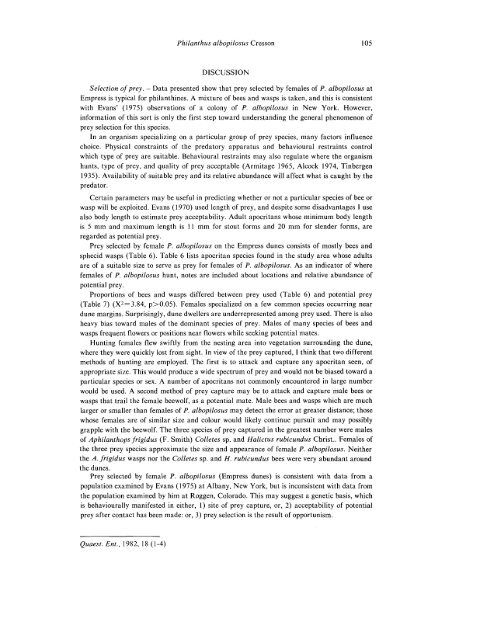Hilchie 1982 QEv18n1_4 91_126 CC released.pdf - College of ...
Hilchie 1982 QEv18n1_4 91_126 CC released.pdf - College of ...
Hilchie 1982 QEv18n1_4 91_126 CC released.pdf - College of ...
Create successful ePaper yourself
Turn your PDF publications into a flip-book with our unique Google optimized e-Paper software.
Philanthus albopilosus Cresson 105<br />
DISCUSSION<br />
Selection <strong>of</strong> prey. - Data presented show that prey selected by females <strong>of</strong> P. albopilosus at<br />
Empress is typical for philanthines. A mixture <strong>of</strong> bees and wasps is taken, and this is consistent<br />
with Evans' (1975) observations <strong>of</strong> a colony <strong>of</strong> P. albopilosus in New York. However,<br />
information <strong>of</strong> this sort is only the first step toward understanding the general phenomenon <strong>of</strong><br />
prey selection for this species.<br />
In an organism specializing on a particular group <strong>of</strong> prey species, many factors influence<br />
choice. Physical constraints <strong>of</strong> the predatory apparatus and behavioural restraints control<br />
which type <strong>of</strong> prey are suitable. Behavioural restraints may also regulate where the organism<br />
hunts, type <strong>of</strong> prey, and quality <strong>of</strong> prey acceptable (Armitage 1965, Alcock 1974, Tinbergen<br />
1935). Availability <strong>of</strong> suitable prey and its relative abundance will affect what is caught by the<br />
predator.<br />
Certain parameters may be useful in predicting whether or not a particular species <strong>of</strong> bee or<br />
wasp will be exploited. Evans (1970) used length <strong>of</strong> prey, and despite some disadvantages I use<br />
also body length to estimate prey acceptability. Adult apocritans whose minimum body length<br />
is 5 mm and maximum length is 11 mm for stout forms and 20 mm for slender forms, are<br />
regarded as potential prey.<br />
Prey selected by female P. albopilosus on the Empress dunes consists <strong>of</strong> mostly bees and<br />
sphecid wasps (Table 6). Table 6 lists apocritan species found in the study area whose adults<br />
are <strong>of</strong> a suitable size to serve as prey for females <strong>of</strong> P. albopilosus. As an indicator <strong>of</strong> where<br />
females <strong>of</strong> P. albopilosus hunt, notes are included about locations and relative abundance <strong>of</strong><br />
potential prey.<br />
Proportions <strong>of</strong> bees and wasps differed between prey used (Table 6) and potential prey<br />
(Table 7) (X 2 =3.84, p>0.05). Females specialized on a few common species occurring near<br />
dune margins. Surprisingly, dune dwellers are underrepresented among prey used. There is also<br />
heavy bias toward males <strong>of</strong> the dominant species <strong>of</strong> prey. Males <strong>of</strong> many species <strong>of</strong> bees and<br />
wasps frequent flowers or positions near flowers while seeking potential mates.<br />
Hunting females flew swiftly from the nesting area into vegetation surrounding the dune,<br />
where they were quickly lost from sight. In view <strong>of</strong> the prey captured, I think that two different<br />
methods <strong>of</strong> hunting are employed. The first is to attack and capture any apocritan seen, <strong>of</strong><br />
appropriate size. This would produce a wide spectrum <strong>of</strong> prey and would not be biased toward a<br />
particular species or sex. A number <strong>of</strong> apocritans not commonly encountered in large number<br />
would be used. A second method <strong>of</strong> prey capture may be to attack and capture male bees or<br />
wasps that trail the female beewolf, as a potential mate. Male bees and wasps which are much<br />
larger or smaller than females <strong>of</strong> P. albopilosus may detect the error at greater distance; those<br />
whose females are <strong>of</strong> similar size and colour would likely continue pursuit and may possibly<br />
grapple with the beewolf. The three species <strong>of</strong> prey captured in the greatest number were males<br />
<strong>of</strong> Aphilanthops frigidus (F. Smith) Colletes sp. and Halictus rubicundus Christ.. Females <strong>of</strong><br />
the three prey species approximate the size and appearance <strong>of</strong> female P. albopilosus. Neither<br />
the A. frigidus wasps nor the Colletes sp. and H. rubicundus bees were very abundant around<br />
the dunes.<br />
Prey selected by female P. albopilosus (Empress dunes) is consistent with data from a<br />
population examined by Evans (1975) at Albany, New York, but is inconsistent with data from<br />
the population examined by him at Roggen, Colorado. This may suggest a genetic basis, which<br />
is behaviourally manifested in either, 1) site <strong>of</strong> prey capture, or, 2) acceptability <strong>of</strong> potential<br />
prey after contact has been made: or, 3) prey selection is the result <strong>of</strong> opportunism.<br />
Quaest.Ent., <strong>1982</strong>, 18(1-4)
















